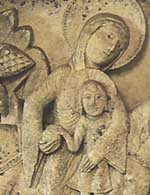| Judith’s dress: |
 |
This is a simple dress in a popular color of the 12th C. The color
combinations that were most appealing at the time include:
Green and gold, orange and green and burgundy, blue and red and orange
and green, and many versions thereof. Our modern sense of aesthetics is
very different than that of the 12th C. and it sometimes takes us a little
while to get used to using these colors together. When you do, however,
you will create a more authentic looking article. Putting a cape or cloak
over the tunic is often seen in the art of the day. I must admit that I
neither make these to sell, nor wear many myself, because it is just to
warm where I live to wear a cloak as a regular piece of your outfit |
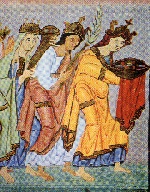 |
from a miniature of emperor Otto III, around the year 1000. The
color combinations here reflect the aesthetic for a few hundred years |
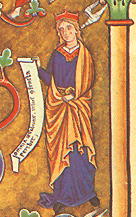 |
From the Tree of Jesse, Psalter of Queen Ingeburge, early 13th C. Chantilly.
Note the 3 different neckline styles visible, and the lower left tunic
is split on the sides. Also note color choices. |
You may ask yourself “Why doesn’t my documented tunic look ‘right’??”
My first answer is "Have you forgotten Head Gear???" As my lord Efenwealt
days “without a hat I am just a guy in a medieval tunic. With a hat, I’m
a medieval guy!” This is so true. The prettiest dress will only look like
a costume if you don’t put the appropriate headgear with it.
| Men's Hats |
 |
For men in the 11th – 12th C. (longer, actually, but that is the time
we are looking at here) a pointed cap with a little "doomiflagee-thingy"
on the top is typical. (Image from the Rheims Missal, 1285) |
 |
from the foot of a cross from the Abbey of Saint Bertin, 2nd half of
the 12th c. By Godfrey of Claire. |
 |
Coifs are another typical piece of headgear for centuries. (Image
from a 12th Century bestiary) The hat could be worn on top of the coif,
or the coif alone. Think of the coif as underwear for your head. If you
weren’t washing your hair often, you would want to protect your hats from
oil and lice. How? By wearing a coif under them. I also believe that the
point at the top of the hat came into use so that you only had to touch
the loop or tag, and keep your greasy filthy hands off the rest of the
hat, thus keeping it cleaner. |
 |
Another style of hat is the Phrygian cap. I have found pictures of
these in manuscripts from the 6th and 9th C. as well as the 12th. They
were worn extensively. This is a cap just like the smurfs wear, actually,
with a bulbous shape hanging over the forehead.(caption: Phrygian cap in
a detail of the Tree of Jesse Stained glass window, to the right of the
royal portal, Chartres Cathedral, 12th C.) |
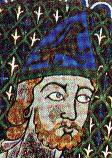 |
A Phrygian cap on the tomb of Geoffrey Plantagenet in Le Mans Cathedral,
12th C. |
| Women's Headgear |
|
 |
For Women, there are several ways to wear a veil, but a veil was always
worn. In the 11th C. there was a round veil with a face hole cut out of
the center, with a circlet of some sort (filet) worn over this, with a
square veil tucked into the back of the circlet. Another style is
to tie a long rectangular veil somehow at the left side of the head, draping
down loosly around chin. (image from part of the portable altar of Stavelot,
1175) |
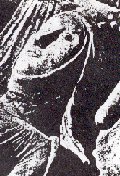 |
In the 12th C. the Barbette and Filet were also worn. A fine example
of this is from the tomb of Eleanor of Aquitaine at Fontevrault. |
 |
The Barbette is a strip of cloth around your chin and pinned at the
top of your head. Over this goes an oval or round veil, and over that goes
a filet- which is a ring made of cloth, around 2” tall that sits
on the head like a hat. (image by Gauteir de Coincy, late 13th C. On the
left is a lady wearing the barbette and Filet over a snood (hair net) and
on the right is a lady in just a filet and veil. The barbette could be
worn with this style as well.) |
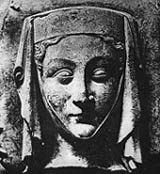 |
In the 13th C. the Barbette was still worn, with a filet on top of
the barbette, and then the round veil folded in half and the folded edge
pinned to the front of the filet. |
 |
veil worn over barbette (From the Rheims Missal, 1285.) |
 |
There is also a picture of a veil being draped over the filet and barbette,
around the neck and shoulders. This filet is fluted or crenelated on the
top- a 13th c. style as well, often worn without the veil at all, but just
over the barbette.(From a 13th C. Bible.) |

